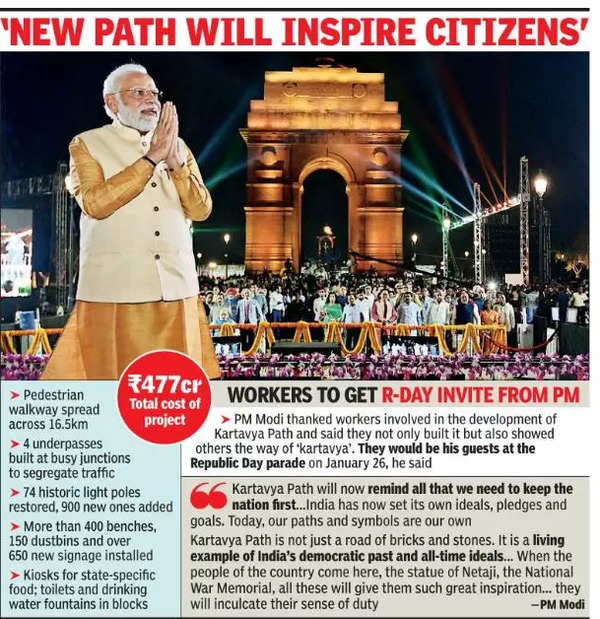“Rajpath, formerly known as Kingsway (before Independence), the symbol of slavery, has become a matter of history from today and has been erased forever. Today, a new story has been created in the form of the Kartavya Path. I congratulate all compatriots on their freedom from yet another identity of slavery, in this “Amrit Kaal” of independence, “the Prime Minister said, promoting the push to remove all signs of colonial rule – one of the five promises he made in his August 15 speech to make India a developed nation by 2047.

“Now, when parliamentarians, ministers and officials embark on the ‘Kartavya Path’, they will remind them of their duties and draw inspiration,” Modi said.
He said that while Rajpath symbolized the power of the ruler, the “Path of Kartavya” represented the sense of duty and the spirit of public ownership and empowerment. Rajpath was for the British Raj to which the Indian people were enslaved, he said.
The Prime Minister also said that the installation of an 8-meter-high granite statue of Netaji at the canopy of India Gate, under which the statue of the British monarch George V once stood, marked the abolition of a another sign of “ghulami” (slavery). He called Netaji “Rashtra Nayak” (leader of the nation), potentially putting the legendary freedom fighter on an even higher pedestal and said the country would rise higher if he followed his ideas.
Saying that the installation of the Netaji statue symbolizes the determination of a strong India, Modi said: “After independence, if our country had followed in its footsteps, India would have reached different heights. But unfortunately, this great hero of ours was forgotten after Independence. His ideas, even the symbols associated with them, have been ignored ”.
The Prime Minister spoke at a glittering ceremony featuring laser shows, rave performances by cultural companies and recitation of a vintage patriotic song. Nationalism was heavy with Modi pointing out that the statue, redeveloped path, and lawns of India Gate represented more than physical structures. They represented a conscious effort to erase the stigma of colonial occupation and to establish the rise of the nationalist spirit of a strong and confident India.
“The spirit of Rajpath was also a symbol of slavery, its structure was also a symbol of slavery,” the Prime Minister said in what sounded like a powerful response to the murmurs that the renaming marked tinkering with history. He referred to a series of government decisions: renaming the Andaman Islands after Netaji; renaming Race Course Road where the PM’s official residence is located as Lok Kalyan Marg; and introduction of Indian musical instruments for the Independence Day ceremonies and the Retreat of the Beat ceremony to erase colonial signatures.
On the recent decision to change the flag and the new ensign of the Indian Navy, he said: “The Indian Navy also adopted the symbol of Chhatrapati Shivaji and abandoned the symbol of the ghulami. These changes are not limited to symbols. These changes are part of the foundations of the country ”. Modi also made it clear that the attempt at decolonization would not stop. “This is neither the beginning nor the end of the government’s goal of erasing the images of colonialism.”
He further stated: “Today the ideals and dimensions of India are yours. Today the determination of India is his and his goals are his. Today our roads are ours, our symbols are ours. Today Rajpath ceases to exist and has become Kartavya Path. Today when the statue of Netaji replaced the mark on the statue of George V, this is not the first example of abandoning the servile mentality. This is neither the beginning nor the end. It is a continuous journey of determination until the goal of freedom of mind and spirit is reached ”.
Modi said that with the renewal of the stretch, its architecture and also its spirit have changed. The project is a sign of how the country is leaving the past behind and paints a new picture of the future. “When people come here, the Netaji statue and the National War Memorial will inspire them,” he said.
On the statue of Netaji, he said that the statue of King George V symbolized British rule. He regretted that Netaji’s contributions have so far not been adequately recognized and stressed that the BJP government under him had done more to honor the charismatic leader of the freedom struggle. “We opened a museum of Netaji and his Indian National Army at the Red Fort, we also renamed the Andaman Islands, where he had hoisted the INA flag after him.”
Modi said the Netaji statue on the “Kartavya Path” will become a source of inspiration and his government has made decisions that bear the impression of Netaji’s ideals for the past eight years.
The PM also expressed particular gratitude to the workers involved in the project for their contribution to the redevelopment of the trafficking. He said he invited all of them and their families to be his “special guest” at the next Republic Day parade. Modi announced that workers engaged in the new Parliament Building project will receive a place of honor in one of his galleries.
Earlier, speaking at the event, Union Minister Hardeep Singh Puri said that after Independence, for the first time, the country’s largest transformation project is being carried out under the leadership of Modi.
